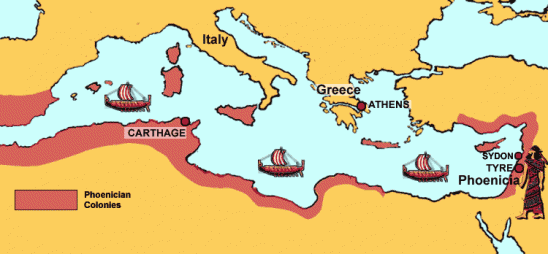 |
| Phoenician Colonies |
Beginning with the Greek Dark Ages, Phoinikoi was the word used by Greeks to refer to the urban populations of the eastern Mediterranean seacoast. Phoenician cities from coastal Syria and Lebanon to the northern shore of Palestine, such as Ras al-Bassit (Poseidon), Tell Sukas (Sianu), Arwad (Arados), Tell Kazel (Sumur, Simyra), Tripolis, Byblos, Beirut, Sidon, Tyre, Ushu, Akhzib, Akko, Tell Keisan, Tell Abu Hawam, and Dor, clung to the rocky islands, sheer cliffs, promontories, and open plains of the coastline.
Inhabitants of these cities shared some degree of common ancestry and spoke a common language, also called Phoenician. The Phoenician-speaking populations were also united by numerous similarities of material culture, social organization, religious belief and practice, and economic enterprise.
The Phoenicians are perhaps most famous for promulgating the 22-letter alphabet in which their documents were composed. The Phoenician alphabet is an ancestor of or inspiration for all succeeding alphabetic systems.
  |
The Phoenician dialect of Tyre and Sidon reached its most extensive use in the Neo-Assyrian period (c. 860–600 b.c.e.). North of Syria, the Cilician region of Anatolia (modern Turkey) adopted the Tyrian-Sidonian Phoenician language and script for royal, administrative, and legal texts, generally with a parallel version in the local Luwian language, which was written in a hieroglyphic script.
Westward expansion of Phoenician exploration and settlement would carry the language and script to Cyprus, Crete, the Aegean islands, Sardinia, Sicily, Malta, the Balearics, and to the Atlantic coast of the Iberian Peninsula. Cádiz, ancient Gades, now in Spain, was the western-most Phoenician city.
 |
| Phoenician harbor and ship |
An eighth-century b.c.e. inscription from Castillo de Doña Blanca (Puerto de Santa María, near Cádiz) identifies its writer as originating from Akko, suggesting that westward expansion radiated from Tyre, as traditionally held.
Tyre was also the mother city of colonies on the African continent: Utica the oldest, Lixus on the Atlantic coast of West Africa the most remote, and Carthage the largest and best known. Phoenician cultural influence extended south to the Sahara and sustained later Christian and Muslim Arab traditions that the indigenous population of North Africa was descended from Canaanites driven out of Palestine by Joshua.
The territory of contemporary Syria, Lebanon, and Israel/Palestine from Ras al-Bassit in the north to Dor in the south was called "Canaan" in ancient times, and people in the western Phoenician diaspora referred to themselves as "Canaanites".
   |
Phoenician material culture is readily detected by the distinctive traditions of pottery form and decoration, with bichrome decoration giving way to black-on-red and an enduring red-slipped style. Phoenician graphic and plastic arts developed Egyptian themes and later Anatolian and European and African styles, often in exquisite miniature forms on seals and amulets.
Early Phoenician settlements generally lack evidence of pork consumption, but later sites under European influence show a more varied diet. Both cremation burials and inhumation were practiced. Western loci exclusively for cremation burials of infants and children are widely interpreted as evidence of ritual infanticide.
 |
| Phoenician trireme |
Phoenician religion was local, polytheistic, and family centered. Lineages of priests male and female conducted animal sacrifices and life cycle rituals; individual piety often combined Canaanite traditions with Egyptian magical practices.
In the Levant, distinctives of Phoenician culture weakened under Hellenistic and later Roman influence. Christianity replaced earlier beliefs in many Phoenician cities; in North Africa, the Punic (late Phoenician) language and some other cultural practices survived—largely among the Christian population—until the Arab conquests.